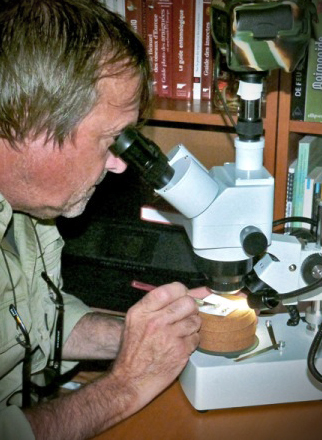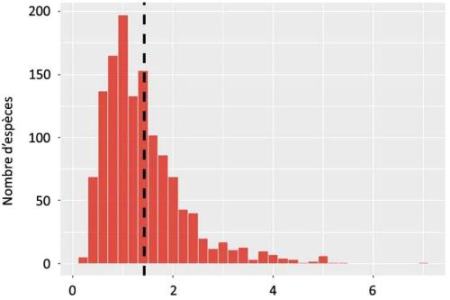Last article published
Soils and their biodiversity
 By observing the ground, we see some of the fauna that inhabits it evolving. But the majority of organisms and the mechanisms that make it live remain hidden from view and are only revealed on dimensional or temporal scales that escape our perception. soils , on which we depend much more than one might imagine at first glance, are little known, both in their physical constitution and in the interactions of all kinds that take place there...
By observing the ground, we see some of the fauna that inhabits it evolving. But the majority of organisms and the mechanisms that make it live remain hidden from view and are only revealed on dimensional or temporal scales that escape our perception. soils , on which we depend much more than one might imagine at first glance, are little known, both in their physical constitution and in the interactions of all kinds that take place there...
Introduction :
In 2016, I shared an ornithological observation post with a friend who, after a long fruitless wait, said to me “Hi Philippe, I am leaving the place. No need to insist, we won't see anything today, so go and photograph some springtails...” I nodded with an air of agreement, although I didn't know what the springtails in question were, apparently so difficult to photograph. Back home, some investigations allow me to discover these arthropods. Surprised to learn that they are among the most widespread on Earth. I set out to observe them. My first outings are terribly disappointing, not the slightest springtail in sight. I will have to deploy a good dose of perseverance to finally achieve
to locate them when they seem infinitely smaller to me than I had imagined. From now on, at least, I will know what to look for.

When I talk about the subject around me, I realize how little springtails are known to the general public. The lack of popular works in French (on this subject I only found a guide 1 , a dossier published in 2010 2 in an entomological journal and an illustrated album 3 ) may explain this state of affairs. Furthermore, scientific publications are difficult to access for the general public, both in terms of their content and their distribution channels. On the internet, I find a few “personal” pages which, without being devoid of interest, leave me wanting more. Fortunately, I discovered the collembola.org site as well as Stephen P. Hopkin 's book 4 , which became my references .
 My encounter with these tiny animals and the desire to observe and photograph them imposed on me some expenses in equipment, without which it would be very difficult to access such a fascinating world. Just as my foray into the field of astronomy had led me to put an astronomy site online , my discovery of the fascinating universe of the " craftsmen of the earth " was also going to give me material for restitution under the form of this site. I only hope that it will not seem too superficial to the informed visitor or off-putting to those who, like me, were unaware until recently of the existence of these Lilliputians.
My encounter with these tiny animals and the desire to observe and photograph them imposed on me some expenses in equipment, without which it would be very difficult to access such a fascinating world. Just as my foray into the field of astronomy had led me to put an astronomy site online , my discovery of the fascinating universe of the " craftsmen of the earth " was also going to give me material for restitution under the form of this site. I only hope that it will not seem too superficial to the informed visitor or off-putting to those who, like me, were unaware until recently of the existence of these Lilliputians.
In terms of documentation, apart from my own observations, I often come up against difficulties in accessing scientific publications that certain organizations preempt in order to keep control of their distribution, which seems to me detrimental to a wide sharing of knowledge. I noted, in an article 4 , a passage which evokes this problem: " The universe of research is characterized by a high entrance fee, which seems to exclude people who do not hold a doctorate or, at least a high level academic training. This situation, which results in a monopoly of researchers in the production of scientific knowledge, has led several actors inside and outside the university institution to launch calls for the democratization of the production of knowledge” .
To conclude on an open reflection, I take up a short passage taken from a work 5 whose reading challenged me: " The dominant mechanisms of science management encourage the production of ever more publications which represent units of increasingly limited information. The explosion of scientific knowledge into a myriad of small contributions has led to an increasing fragmentation of science, perhaps excluding insights that could help meet the challenges of the Anthropocene… Driven by the processes of economic globalization , national science policies are increasingly focused on international competitiveness, potentially limiting the extent of curiosity-driven research, and thereby running the risk of missing opportunities that are off the beaten path. No major society today can apparently afford the luxury of not maintaining and regulating its science and education systems other than according to globalized models. Given the unpredictable and inevitably random nature of innovation, it would be myopic to want to force science to concern itself only with the challenges within our reach… ”
Arthropods and a fortiori springtails are therefore not “star” subjects in the world of research, compared to the scientific challenges discussed in Jürgen Renn's book. However, I am delighted to see biologists still devoting themselves to improving knowledge about these animals. When it comes to research, necessity and curiosity should not give way to each other, but move forward simultaneously. Indeed, no one can predict the possible bridges that may emerge in the light of the publications of each of the two "camps".
Since 2021, I have reduced the time I devote to tracking down new species and photographing them, but I nevertheless remain attentive to scientific news concerning them and I strive to enrich this site by drawing inspiration from publications. the most affordable by using the most accessible language possible.
 Anecdote: In July 2022, while I was reading "A Mammoth Memory"*, the latest work of the paleontologist, now deceased, Yves Coppens, known worldwide for being, with his team, the discoverer of our ancestor "Lucy". What was my surprise to find my name there, mentioned in the paragraph "a drop of science" ( chap 33).
Anecdote: In July 2022, while I was reading "A Mammoth Memory"*, the latest work of the paleontologist, now deceased, Yves Coppens, known worldwide for being, with his team, the discoverer of our ancestor "Lucy". What was my surprise to find my name there, mentioned in the paragraph "a drop of science" ( chap 33).
Flattered that a member of the Academy of Sciences, a professor at the College de France, had noticed my work on springtails, I could only be comforted in continuing my adventure with these little animals.
 Note: About the size of springtails, I reproduce here a histogram extracted from the BETSI database. This illustration (established by J.Bonfanti - 2018) shows the distribution of the average length of springtails (by 0.2mm steps). It is based on the study of 1292 species of springtails in Europe. The vertical black bar, in dotted lines, indicates the average value of the analyzed data set, i.e. 1.44 mm.
Note: About the size of springtails, I reproduce here a histogram extracted from the BETSI database. This illustration (established by J.Bonfanti - 2018) shows the distribution of the average length of springtails (by 0.2mm steps). It is based on the study of 1292 species of springtails in Europe. The vertical black bar, in dotted lines, indicates the average value of the analyzed data set, i.e. 1.44 mm.
Here is therefore the dimensional scale that I will be confronted with to take my shots and the observations that will be used to illustrate this site.
Etymological precision : The French term springtail comes from the ancient Greek " κόλλ α", kólla (glue) and " ἐ μ βάλλω ", emb á ll ô (to throw in). If the jumping character of the collembola is well signified by the Greek term emb á ll ô , the presence of the term k ó lla (glue) is less obvious. We can presume that it comes from the fact that observations show the ability of springtails to remain attached to smooth vertical or even upside-down walls. But, when we know that the ends of its legs are provided with claws, the fact that it can remain thus fixed remains enigmatic. We then find an explanation in the morphology of the springtail, with the presence of a ventral tube named collophore - ko'lla (glue) fe'rein (carry) - this organ is able to maintain the springtail on smooth surfaces, thanks to sorts of micro-suction cups with which it is provided (see here). Thus, we have an explanation for the two particularities of springtails that led to their being so baptized.
The more recent English term Springtail is constructed from the words " spring " (to jump), not to be confused with its namesake meaning spring, and " tail " (tail). In the English version of this site I use the term springtail , which is more common than Collembola , the Latin form used by biologists. Term that even has its derived adjective: collembolan.
Contact me for any comment or information to enrich this site.
Photo: Corinne Rolland - Photographer - Visit her gallery.
Sources:
1 These tiny animals - Y.Coineau / R.Cléva / G.du Chatenet -Delachaux and Niestlé - 1997.
2 Collembola planet , the secret life of soils - Biotope edition - Jérôme Cortet / Philippe Lebeaux
3 The small illustrated springtail - Arvensis (2010) – Jean-Marc Thibaud / Cyrille A. D'Haese- (download n° 51-52)
4 Biology of the spingtails - Oxford University Press (1997) - Stephen P. Hopkin
5 Godrie Baptiste, “Egalitarian relations in the production of scientific knowledge. The example of participatory research in mental health”, Vie sociale, 2017/4 (n° 20), p. 99-116. DOI: 10.3917/vsoc.174.0099. URL: https://www.cairn.info/revue-vie-sociale-2017-4-page-99.htm
6 “ The evolution of knowledge ” Jurgen Renn 2022 – Publisher “belles lettres” Paris.